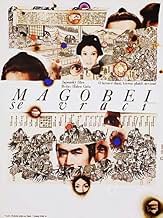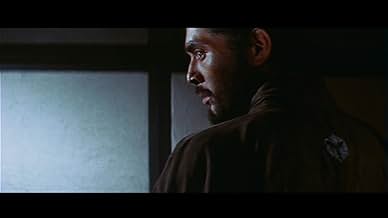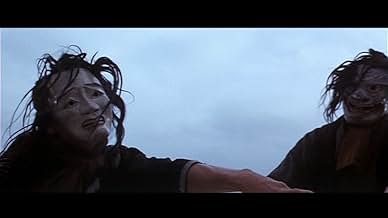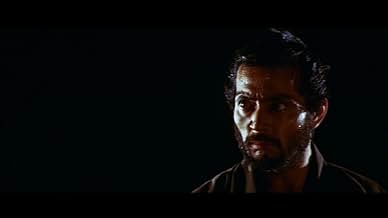NOTE IMDb
7,6/10
2,8 k
MA NOTE
Ajouter une intrigue dans votre langueA guilt-haunted samurai warrior attempts to prevent a massacre from taking place.A guilt-haunted samurai warrior attempts to prevent a massacre from taking place.A guilt-haunted samurai warrior attempts to prevent a massacre from taking place.
- Réalisation
- Scénario
- Casting principal
- Récompenses
- 2 victoires et 1 nomination au total
Avis à la une
This is a special beast of a samurai film because of several things.
For starters it is often compared unfavorably to "Sword of Doom" (completely nihilist B&W psycho samurai also starring Tatsuya Nakadai as a clone of his Yojimbo character). Quite frankly, Goyokin is far superior in nuance, photography and character depth. It holds that edge and an inherent darkness that is exquisitely explored visually over most samurai films in existence: more poetic than Zatôyichi (2003, Kitano), better filmed and written than Sword of Doom (1966, Okamoto), less remote than Ran (1985, Kurosawa) and darker and deeper than Yojimbo (1961, also Kurosawa); the only samurai to best this is Seven Samurai.
Tatsuya Nakadai comes across as three-dimensional, which is a departure from most chambara film heroes, and tormented but eminently likable. Every character is given sufficient growth and motive. Masaru Sato gives us one of his finest scores ever (the other being that of Yojimbo). The photography defeats any samurai film that could possibly cross your mind (yes, even Ran and by a narrow margin Seven samurai's stark B&W beauty)! The fights have a sincere brutality and make the most of their environment... There is little else to add... well no maybe there is. Don't go in expecting pop-corn entertainment but rather something deeper more complex.
I've heard that Inagaki's Samurai trilogy was Japan's "Gone With the Wind", Red Beard it's "Titanic" and Seven Samurai its ultimate western... if so, "Goyokin" is its "Lawrence of Arabia"!
For starters it is often compared unfavorably to "Sword of Doom" (completely nihilist B&W psycho samurai also starring Tatsuya Nakadai as a clone of his Yojimbo character). Quite frankly, Goyokin is far superior in nuance, photography and character depth. It holds that edge and an inherent darkness that is exquisitely explored visually over most samurai films in existence: more poetic than Zatôyichi (2003, Kitano), better filmed and written than Sword of Doom (1966, Okamoto), less remote than Ran (1985, Kurosawa) and darker and deeper than Yojimbo (1961, also Kurosawa); the only samurai to best this is Seven Samurai.
Tatsuya Nakadai comes across as three-dimensional, which is a departure from most chambara film heroes, and tormented but eminently likable. Every character is given sufficient growth and motive. Masaru Sato gives us one of his finest scores ever (the other being that of Yojimbo). The photography defeats any samurai film that could possibly cross your mind (yes, even Ran and by a narrow margin Seven samurai's stark B&W beauty)! The fights have a sincere brutality and make the most of their environment... There is little else to add... well no maybe there is. Don't go in expecting pop-corn entertainment but rather something deeper more complex.
I've heard that Inagaki's Samurai trilogy was Japan's "Gone With the Wind", Red Beard it's "Titanic" and Seven Samurai its ultimate western... if so, "Goyokin" is its "Lawrence of Arabia"!
After reading all the raves about this movie I was looking forward to finally watching it. I have to admit to being somewhat let down. Mind you it is a good movie with Nakadai putting in a great performance as a haunted samurai. Maybe I have seen too many samurai or movies from the east but the story seems formulaic for me (I am also watching it over 40yrs since it was made and the movie is older then I am). I still give this movie a 7 rating as it is a good movie but there definitely are better ones. Note: I watched Goyokin after The Sword of Doom. Nakadai's performance is better in this movie but I enjoyed The Sword of Doom more as a whole.
I just had to write something when I saw that the current spotlighted user's comment calls this movie merely "decent." I just got back from seeing it on the big screen, and believe me, it's WAY more than "decent." More like amazing. I am truly grateful to have had the opportunity to see it. I'll be the first to admit that it's at times narratively challenging, and that the main character is fairly one-note. But it really compares in many respects with classic westerns like The Searchers. Plus a truly inventive, exciting, and striking climax. Full of visual poetry. Ten lines really does seem like a bit much to require people to write. Would six be so awful? All I really wanted to do was provide some balance to the "decent" comment. Wow. I'm still just at nine lines. Okay. See this on the big screen if you have a chance. It's truly a widescreen picture that uses the frame quite inventively at times. And that's eleven lines, so I'm done.
I saw this film in the late 1970s. It was called "Goyekin - The Emperor's Gold". As I watched our guilt-ridden hero return to fulfill his promise, really a threat, to punish his family if they repeated their crime. I still see the image of him striding along the beach with a conical hat pulled low. The shadow on his face made his eyes glow under the hat and the shot was taken with a telephoto through wispy beach grass. Completely memorable. Then the scene in the forest with the horsemen riding through. It looked like an ancient Japanese painting with hazy colors and an other-worldliness that was amazing. Then the concluding duel in the snow. Two brilliantly attired samurai dueling in a pure white, glistening environment. So many great images from one film!
The film itself is a pretty typical revenge film with some twists. When Tom Laughlin tried to redo it as a Mexican western,"The Master Gunfighter", it just fell flat. But the samurai movie has an entertaining plot and good action characters with beautiful settings. I think this film is a special case of cinematographic excellence. See it and enjoy the beauty.
The film itself is a pretty typical revenge film with some twists. When Tom Laughlin tried to redo it as a Mexican western,"The Master Gunfighter", it just fell flat. But the samurai movie has an entertaining plot and good action characters with beautiful settings. I think this film is a special case of cinematographic excellence. See it and enjoy the beauty.
From the truly creepy opening to the climax, this movie holds your attention, both with its cinematography and (more preciously) a gripping and coherent storyline.
Excellent filming techniques in this film hold your attention, when the suspense (yes! actual suspense!) doesn't. The acting (by Nakadai Tatsuya, one of Japan's greatest actors -- far better than Mifune Toshiro, IMHO) is top notch. Finally, the violence (though there's plenty) never degenerates into splatter. The violence appears much more disturbing (intentionally so) and much less titillating than in many "chambara" movies.
Also noteworthy, this movie plays on the "loyalty vs. morality" theme that Gosha seems so fond of hammering. In this particular movie, however, he really pulls it off with some intelligence. Though I'm a big fan of Gosha, I have to admit that not everything he touches turns to "gold" (Get it? You will...).
Even so, if you're going to sample from the "chambara" genre, this is among the best (my other nominee would be "Hitokiri/Tenchu" (1969). Frankly, I think it's among the best Japanese films, period.
Excellent filming techniques in this film hold your attention, when the suspense (yes! actual suspense!) doesn't. The acting (by Nakadai Tatsuya, one of Japan's greatest actors -- far better than Mifune Toshiro, IMHO) is top notch. Finally, the violence (though there's plenty) never degenerates into splatter. The violence appears much more disturbing (intentionally so) and much less titillating than in many "chambara" movies.
Also noteworthy, this movie plays on the "loyalty vs. morality" theme that Gosha seems so fond of hammering. In this particular movie, however, he really pulls it off with some intelligence. Though I'm a big fan of Gosha, I have to admit that not everything he touches turns to "gold" (Get it? You will...).
Even so, if you're going to sample from the "chambara" genre, this is among the best (my other nominee would be "Hitokiri/Tenchu" (1969). Frankly, I think it's among the best Japanese films, period.
Le saviez-vous
- AnecdotesThis is the first Japanese feature film in Panavision.
- ConnexionsFeatured in Trailer Trauma V: 70s Action Attack! (2020)
Meilleurs choix
Connectez-vous pour évaluer et suivre la liste de favoris afin de recevoir des recommandations personnalisées
- How long is The Steel Edge of Revenge?Alimenté par Alexa
Détails
- Durée2 heures 4 minutes
- Mixage
- Rapport de forme
- 2.35 : 1
Contribuer à cette page
Suggérer une modification ou ajouter du contenu manquant

Lacune principale
By what name was Goyokin: La terreur des sabaï (1969) officially released in Canada in English?
Répondre




























